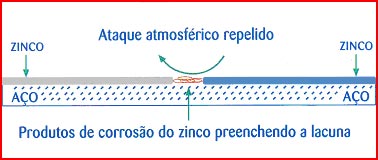Zinc is essential for a modern society. Zinc is the most efficient method in terms of cost and environmental safety to protect steel from corrosion.
Prolonging the live of steel, zinc provides a priceless service, since it helps save natural resources like iron ore and energy, as well as prolonging the life of products and capital investments in steel, like houses, bridges, port facilities, energy and water distribution lines, telecommunications and transport.
The main uses of zinc are:
Zinc is also an indispensable essential element for human health and for all living organisms.
Galvanizing
The process of Hot-Dip Galvanizin results in a metallurgical bond between zinc and steel, providing steel with an anti-corrosive coating that is more advanced and cost-efficient. Galvanized steel is used where corrosion is a threat.
How does Zinc Protect Against Corrosion?
When exposed to the air and water, iron and steel will rust. A layer of zinc provides triple protection. First, zinc provides a resistant and adherent coating that seals the underlying metal from contact with the corrosive environment. Second, zinc corrodes more slowly than iron. Third, if the coating is damaged and the steel is exposed (accidentally, or by a cut or perforation), the zinc layer will protect the exposed steel (this extraordinary property is called "anodic protection"). The life of the coating is prolonged even more because the zinc corrosion products tend to seal damaged areas.

Brass
Brass is a family of copper and zinc alloys. The zinc content in brass generally varies from 10% to more than 40%. Besides its traditional use in door handles, lights and decorative objects, brass is becoming more and more popular among architects, decorators and consumers.
Brass has a warm and natural color and feel. Bronze is also a hygienic material – when it is used in door handles, windowsills and hardware, it has the added benefit of being anti-bacterial.
Pressure die casting
The resistance and fluidity of cast alloys based on high purity grade zinc make it ideal for thousands of foundry uses, such as domestic utensils, precision parts for cars, computers and communications equipment.
Architecture
The plasticity and resistance to corrosion of zinc plating make it an ideal material for roofs, rainwater drainage and decoration
Galvanized steel is becoming more and more used in industrial, commercial and residential construction, window and door frames, conduits and coverings.
Principal Uses of Zinc: Human, Animal and Plant Health.
The curative properties of zinc compounds allow its use in many pharmaceutical and cosmetic products, ranging from bandages and anti-septic creams to sunscreens.
The main uses of zinc compounds are in the production of rubber, animal food, fertilizers and human nutrition.
Four Key Factors about Zinc
Natural
Zinc, like all metals, is a natural component of the earth's crust and an inherent part of our environment. Zinc is not only present in the rocks and soil, but also in the air, water and biosphere (plants, animals and humans). Zinc is constantly transported by nature, in a process called "natural cycling." Rain, snow, ice, sun and wind lead to erosion of rocks and soil that contain zinc. The wind and water carry small quantities of zinc to lakes, rivers and the sea, where it sediments or is transported to other locations. Natural phenomena like volcanic eruptions, forest fires, dust storms and ocean water droplets contribute to the continuous movement of zinc in nature.
Protective
The most notable quality of zinc is its natural capacity for protection. Zinc coatings protect steel against corrosion, extending its useful life by up to five times. For this reason, vehicle manufacturers can offer guarantees against corrosion of 12 years or more.
Consequently, zinc helps to preserve the value of a typical family investment. Zinc also protects human health. It is known that zinc is essential for human health in general, and particularly for proper functioning of the human immunological system. Creams and lotions containing zinc are widely used to protect the skin from the harmful effects of the sun. Zinc is used in water purification systems and zinc supplements are added to the soil to protect crops.
Sustainable
The principal condition of sustainability is to satisfy present needs without compromising the capacity of future generations to satisfy their needs, too. Thus, sustainability concentrates on economic growth, environmental protection and social process. Zinc makes a significant contribution to sustainable development. In its role as the protector of steel, zinc is an essential material for the development of public and private infrastructure, prolonging the useful life of goods and structures in steel and reducing maintenance costs. As an essential natural element, zinc is part of all ecosystems.
Zinc is completely recyclable, providing a sustainable resource for future generations. Zinc also contributes to social progress by providing shelter at a reasonable cost, promoting good health and contributing to the durability of infrastructure and transport systems on which a modern society depends.
Does not harm the environment
All life on earth developed over hundreds of millions of years in the presence of zinc. Zinc is used by nature for countless biological processes. For these reasons, zinc is called an "essential element", which means that it is essential to the health of living organisms. Plants, animals and humans regulate their ingestion of zinc from nature. The possibility that industrial emissions during recent years could be leading to an increase in zinc levels in the environment was raised. However, since the 1970s, progressive control of emissions in refineries and industrial facilities reduced these emissions considerably. At the same time, general pollution control greatly reduced the acidity of the air in most of the industrialized countries, making zinc coatings on exposed steel plating even more durable. Currently, the amount of zinc in the environment is close to natural historic levels. In other words, man's activities are no longer affecting the natural equilibrium of zinc in the environment.
We use essential cookies and similar technologies in accordance with our Privacy Policy and by continuing to browse, you agree to these conditions.